|
|
Form-factors of mobile phones, part three
Sliders or in pursuit of style
As the number of various offerings on the market was growing up, while the clamshells were loosing the aura of nifty handsets, the manufacturers were forced set out on a quest for a solution that would be fashion-savvy and draw attention of consumers. The rescue came in the form of sliders (from English verb to slide). The first handset styled in this form-factor was presented by Siemens in 1998, the Siemens SL10 (copycat of the monoblock-shaped Siemens S10, when it comes the feature set). The maker called the mechanism ProSlide, later on he would shift back to this name and use it in contemporary models, for example the Siemens SL55 (after five generations). The manufacturer underscored that the slider-style form made for more portable dimensions, since the SL10 measured 129 mm tall, whereas S10 had 150mm.
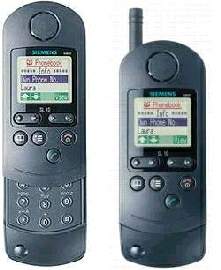
Another step up in the slider evolution ladder was made by the Nokia 7650, announced early in 2002. Sometimes it is wrongfully taken as the first slider ever made.
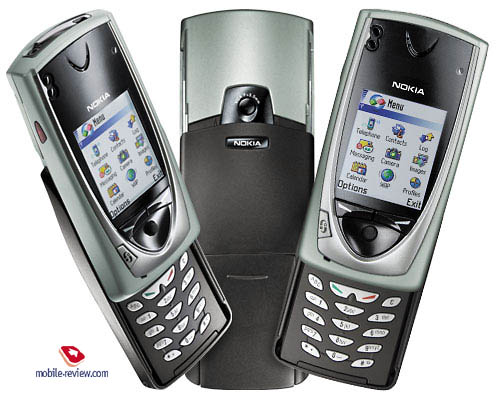
But what really has stirred up the development of the form-factors, was Samsung’s efforts, which thought it could build up the slider cult on the European market, much like the one for clamshells. The company had started pushing the segment in 2003 and by the middle of 2006 it had sliding phones priced at 150 USD and higher. Although other manufacturers lagged behind with responding to the needs of the emerged market, they put in own solutions as well. Today, it is Samsung that is in commanding position over the slider phone market.

Slider – the handset consists of two halves that slide relative to each other, and normally when it is shut, you see the display, and flicking it open allows you to manage the keypad. In traditional sliders both halves provide for the device’s functionality, which means they house important components (saving for a number Nokia’s solutions). There are also some exotic solutions, having the display hidden and the top half with an extra display and keypad or an extra display alone. The spring loaded mechanism makes for smooth processes of sliding the device open and closed.
On the borderline between sliders and flip-armed candy-bars, reside several models, mainly Nokia’s fashion phones coming from the 8000-series. These handsets feature the flip over the keypad, which is opened in similar fashion to sliders – you push the casing upwards. And technically, they can be attributed to sliders. Now the Nokia 8910 is something worth looking at (announced in summer 2002) – the keypad here is covered by a special shroud, that throws the handset’s main part up upon pressing the side-keys. And slid-closed it exposes only the display. This is another way of making sliders, and one of one of the important difference is that the covers usually don’t have any wires or chips embedded inside, and thus having them broken doesn’t mean it is about time to throw this device away.
In February 2007 Motorola showcased its concept of its ergonomic slider design – the halves are curved in a way that provides “fit-to-face” profile when flicking the handset open. The Motorola Z8 sports no additional joints, hinges, whatsoever – the fact of the matter is that the halves were initially designed with this profile in mid and upon opening they just bend as they are meant to.
 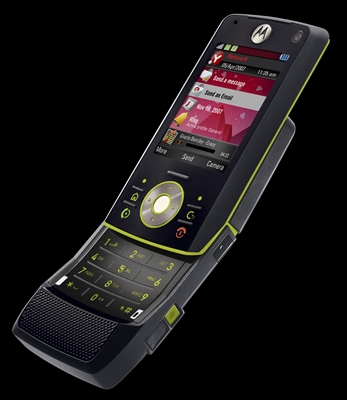
However the idea of this design, despite Motorola “reinventing the slider phone” with the Z8 is nothing new. On September 9, 1996 Nokia revealed the Nokia 8110, which had “banana” nickname stuck to it shortly after the release for having a very characteristic looks with the flip opened up. Here is a quote taken from the press-release: «The Nokia 8110 is the first of its kind in terms its ergonomics. It feels good in the hand and fits into any pocket. The revolutionary curved design fits the natural shape of your face. It has unique sliding mouthpiece for maximum voice quality. The mouthpiece, which has microphone embedded within it, both protects the keypad and slides forward to fit the contour of your chin, explained Mr Juha Reima, Managing Director for Nokia Mobile Phones, Southeast Asia».
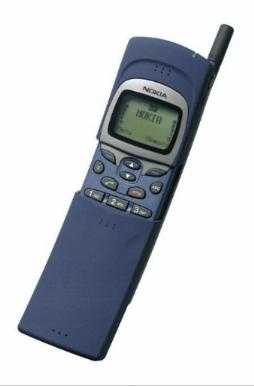
The Nokia 8110 also was involved in a very remarkable story – back in 1999 the world saw The Matrix, which was more than a bestseller, it was a whole cult. And the main character there, Neo used the Nokia 8110, but with auto opening mechanism, which was missing in the production units. The model went on to be the movie’s featured handset and receive Matrix Phone name. However by the time The Matrix actually hit the big screen, Nokia 81100 had already been taken out of production and there was no way to get hands on the same device Neo had in the movie. The Nokia 7110 was trying to seem a sort of counterpart, but it never became that “Matrix Phone”, even though was selling pretty well.


In the sequel to the original Matrix, Samsung stepped onto the scene with its own variation of the “The Matrix Phone”, which was made up for CDMA-networks literally from the ground up exclusively for the movie, although limited editions were available across the globe, mainly in the US, where this movie was tremendously popular. And much of a unique move on Samsung’s side this was, inasmuch as this was the first occasion when a movie got an actually working device with original design released as a limited edition. This phone was featured to a greater or lesser extent in all Samsung’s materials, which brought much benefit to the movie itself. Indeed, this model is so sought-after, that even nowadays we receive requests to sell it for quite much money. Following in the footsteps of the movie, this phone has formed on own cult and had an impact on its maker’s image on the whole.

Starting from the Nokia 8110 onwards, the handsets styled in this way has been known as “bananas”, and it was quite expected that someone of the vendors would employ it as official name for an own model. Shortly after the Motorola Z8’s debut, LG displayed LG Banana Phone (LG SV-280) for the Korean market.

This example shows that frequently the ideas and concepts on the mobile phone market develop in a spiral, and the things that didn’t hit pay dirt a couple of years ago, might be successfully reanimated today.
What is coming tomorrow?
It wouldn’t be right to expect something out of the ordinary from the manufacturers in the years to come – all new form-factors will be nothing but modifications of the existing solutions with some new ergonomics or functionality tacked on. While studying patens, you can easily track the direction of development of mobile phones form-factors. For instance, Sony Ericsson filed an application for a patent for a form-factor called Flipper, where a clamshell’s top part housing the display is made swiveling, so that the screen rotates within a frame.

In its turn, Samsung has received a patent for a hinge, with whose help two halves of a communicator can make a 360-degree turn. Another concept of what may be the phone of tomorrow.
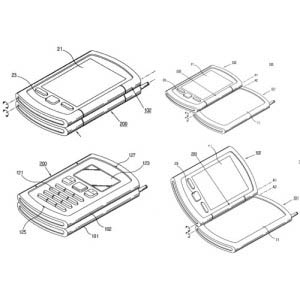
Projected keyboard or even handset’s display won’t get out of the developers’ minds, though for now these technologies are too whimsical and remain nothing more than plans for the future.

You can also see for yourself that even all these patents don’t put up any fundamentally new form-factors, which may emerge as soon as materials and microelectronics make a major leap up. To, me, the most fetching invention would be a candy-bar with the ability to morph the casing’s geometry, so as to attune it to the owner’s anatomy. But that’s something we will not see the day after tomorrow for sure.
Related links:
Eldar Murtazin (eldar@mobile-review.com)
Translated by Oleg Kononosov (oleg.kononosov@mobile-review.com)
Published — 12 June 2007
Have something to add?! Write us... eldar@mobile-review.com
|
News:
[ 31-07 16:21 ]Sir Jony Ive: Apple Isn't In It For The Money
[ 31-07 13:34 ]Video: Nokia Designer Interviews
[ 31-07 13:10 ]RIM To Layoff 3,000 More Employees
[ 30-07 20:59 ]Video: iPhone 5 Housing Shown Off
[ 30-07 19:12 ]Android Fortunes Decline In U.S.
[ 25-07 16:18 ]Why Apple Is Suing Samsung?
[ 25-07 15:53 ]A Few Choice Quotes About Apple ... By Samsung
[ 23-07 20:25 ]Russian iOS Hacker Calls It A Day
[ 23-07 17:40 ]Video: It's Still Not Out, But Galaxy Note 10.1 Gets An Ad
[ 19-07 19:10 ]Another Loss For Nokia: $1 Billion Down In Q2
[ 19-07 17:22 ]British Judge Orders Apple To Run Ads Saying Samsung Did Not Copy Them
[ 19-07 16:57 ]iPhone 5 To Feature Nano-SIM Cards
[ 18-07 14:20 ]What The iPad Could Have Looked Like ...
[ 18-07 13:25 ]App Store Hack Is Still Going Strong Despite Apple's Best Efforts
[ 13-07 12:34 ]Infographic: The (Hypothetical) Sale Of RIM
[ 13-07 11:10 ]Video: iPhone Hacker Makes In-App Purchases Free
[ 12-07 19:50 ]iPhone 5 Images Leak Again
[ 12-07 17:51 ]Android Takes 50%+ Of U.S. And Europe
[ 11-07 16:02 ]Apple Involved In 60% Of Patent Suits
[ 11-07 13:14 ]Video: Kindle Fire Gets A Jelly Bean
Subscribe
|














